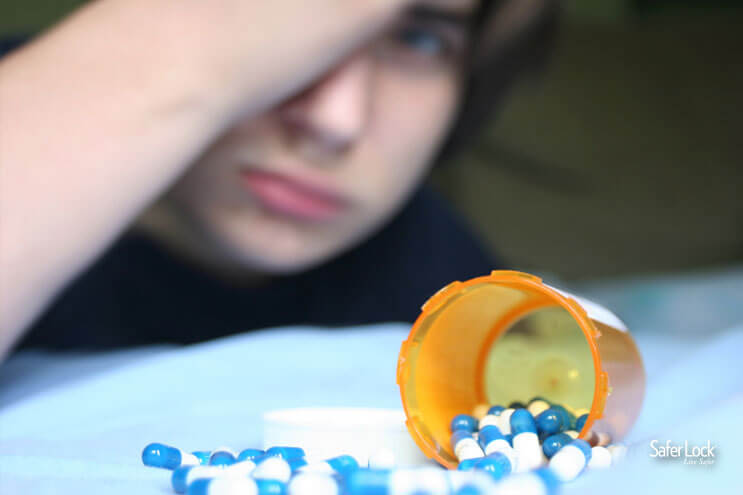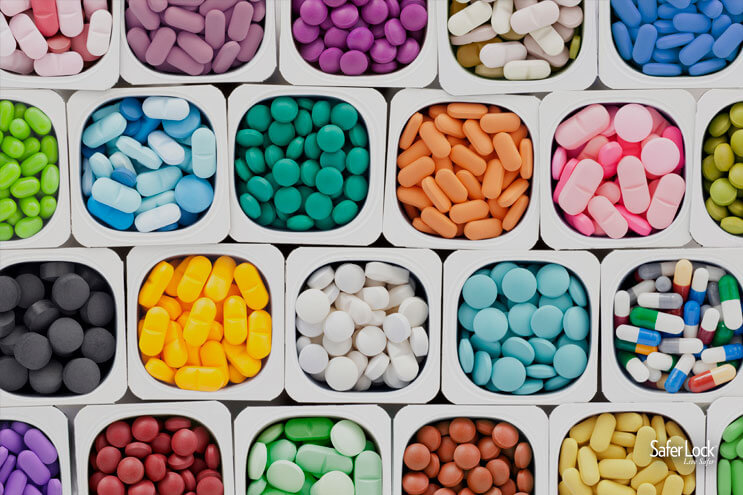Has someone been “shopping” in your medicine cabinet?
The prescription medications you keep in your home may be more appealing, and far more dangerous, than you think.
- Prescription medications are a common source of drug misuse, especially among teens.
- Even one pill can kill, especially with the rise of fentanyl-laced counterfeits.
- Many teens start with stolen pills, leading to lifelong struggles with substance misuse.
- Watch for warning signs of tampering or missing medications.
- Locking your meds with a locking medicine box protects your health, your family, and your peace of mind.
More than 13 million people in the U.S. misuse prescription drugs, such as prescription painkillers, sedatives, and stimulants, according to the Substance Abuse and Mental Health Services Administration (SAMHSA). That includes taking medications in ways other than prescribed, using someone else’s prescription, or obtaining pills illegally.
Sometimes, misuse means doubling up on doses or taking a pill sooner than recommended. But often, it means stealing pills from family, friends, or even strangers.
It’s not uncommon for teens and adults alike to swipe medications from:
- A parent’s nightstand
- A friend’s bathroom cabinet
- A neighbor’s purse
- Or even during real estate open houses
And sometimes, the person taking those pills lives just down the hall.
A 2023 Monitoring the Future survey found that nearly 50% of high school seniors said it would be fairly easy or very easy to get prescription painkillers.
However, the latest version of the MTF survey found the percentage of 12th graders who reported misusing prescription narcotics (such as OxyContin) dropped to an all-time low of 0.6% in 2024.
Attitudes Towards Prescription Medications
Teens and their parents tend to dismiss the real risks of pilfering powerful prescription medications.
Here’s why:
Attitudinal studies show that parents and teens alike believe powerful medications are safe because “they were prescribed by a doctor.”
Interviews of parents with teen children revealed that parents often keep prescription drugs in the home without taking any measures to keep teens out of the medications. Misconceptions are common, including the belief that children cannot get high from prescription drugs or that their kids would not be interested in them. “Not my kid” is a common misconception that can lead to easy access to dangerous medications.
Teens often think that they are bulletproof from harm. Their brains are developmentally primed to seek thrills and risk, seek belonging from peers, and throw caution to the wind.
Both teens and parents alike can be unaware of the dangers of teen substance use, which increases the risk of substance misuse or disorders later in life.
Many parents don’t even realize their pills are missing, especially if a prescription is no longer needed.
Secure your prescription medications using the Safer Lock Box, featuring a combination locking cap.
A Single Pill Can Kill or Set the Stage for Substance Abuse
A mistaken belief that prescription pills are safe, or at least safer than illicit drugs, can be deadly.
The leading cause of overdose deaths in the United States comes from synthetic opioids, such as fentanyl.
Fentanyl can be 50-100x more potent than heroin and morphine. Fentanyl has flooded the illegal drug market and is often used in making counterfeit pills such as painkillers. What looks like a prescription pill could contain a lethal dose of fentanyl.
Many families have faced the devastating reality that a single pill can kill.
“She thought she was taking a prescribed pill, but in reality, it was a fake pill laced with fentanyl,” warns Veronica Kaprosky, who learned that one pill can kill when she lost her teen daughter to fentanyl.
“My life has been devastated by the loss of my daughter.”
Even legitimate prescription medications, untainted by fentanyl, can be deadly. Teens often mix opioids with other drugs or alcohol, which can create a deadly cocktail that slows down reaction time or impairs breathing, leading to fatal accidents or accidental overdose.
Prescription medication abuse can set the stage for substance abuse. Nearly 90% of people who inject heroin started by abusing prescription drugs, obtaining pills from friends, family members, and personal prescriptions, reports the National Institute on Drug Abuse.
Family members are often unwitting suppliers, not knowing that their prescription pills are being taken from medicine cabinets without permission.
Those first pilfered pills can lay the neurological foundation for a lifetime of struggle with addiction to drugs or alcohol (known as substance use disorder or SUD). Early exposure to alcohol or other drugs can change the way the teen brain develops, making it more vulnerable to the development of SUD.
Prescription Misuse Can Lead to Opioid Use Disorder
It doesn’t take long for misuse to become a pattern. According to the National Institute on Drug Abuse, many people who develop substance use disorders began by misusing prescription drugs, often taken from friends, relatives, or leftover personal prescriptions.
These early exposures, especially during the teen years, can alter the way the brain develops, increasing the risk of substance use disorders later in life.
Having powerful prescription medications within easy access of curious teens can pave the way for a future of substance misuse, disorders, and potentially fatal overdoses.
Is Someone Stealing Your Prescription Meds?
If you suspect that your prescription painkillers or other medications are going missing, there may be warning signs.
- Your medication bottle is not in the same place you left it.
- The cap isn’t on securely or isn’t even on at all.
- Your medication bottle doesn’t open as smoothly as before, or the top may be difficult to remove.
- Your medication bottle shows physical signs of attempted entry, such as dents or cracks.
- Your medication bottle is wet on the outside or inside, or the contents are wet.
- The contents, such as capsules or pills, look different than they usually do, which may indicate that some or all have been removed and replaced with another look-alike pill (which can be dangerous to both patient and pilferer). The capsules or pills may not be the same size, thickness, length, or color. Some of the pills may be broken. The capsules or pills may have a strange or different odor or taste.
- It appears as if you have fewer pills than you usually have in your medication bottle. You find yourself refilling your prescription more often than before. You might even think that your pharmacist mistakenly “shorted” your prescription.
- And, of course, if your medication bottle is missing entirely or has been broken open, you’ve got an undeniable problem on your hands.
Lock Your Meds, Protect Your Family and Rx
Missing pills can be a problem for you and your family. If your medication starts to go missing, it may be difficult to get a refill.
Securing your medications in a medication lock box or other locking pill system is a simple preventative measure to ensure your children are safe from misguided attempts to experiment with powerful prescriptions.
Explore our collection of abuse-deterrent, tamper-evident medication storage solutions.
FAQ: Preventing Prescription Medication Misuse at Home
Why are prescription medications a target for theft or misuse? Prescription painkillers, sedatives, and stimulants can create a high when misused. Teens and adults often believe they are safer than street drugs because they come from doctors, making them a common target for pilfering.
How common is prescription drug misuse among teens? Nearly 50% of high school seniors report that prescription painkillers are fairly or very easy to obtain. While misuse of narcotics like OxyContin has dropped to historic lows, access and risk remain high.
What are the risks of taking pills not prescribed to you? Even legitimate prescriptions can be dangerous when misused. Mixing opioids with alcohol or other drugs can slow breathing and lead to fatal overdoses. Counterfeit pills may contain fentanyl, a synthetic opioid up to 100 times stronger than morphine, which can be deadly in tiny doses.
How can parents tell if someone is stealing their medications? Warning signs include missing pills, bottles moved from their original spot, caps that are loose or damaged, pills that look different, bottles with dents or moisture, or needing to refill prescriptions sooner than expected.
Why do teens think prescription drugs are safe? Many teens and parents mistakenly believe prescriptions are less risky because they come from a doctor. Developmental factors also make teens more likely to seek thrills and underestimate the danger of medication abuse.
How does prescription misuse lead to long-term addiction? Studies show nearly 90% of people who inject heroin started by misusing prescription drugs. Early exposure can alter brain development, increasing the risk of substance use disorders later in life.
What can families do to prevent prescription misuse? Secure medications in a locking pill bottle or medicine lock box. Regularly count your pills, dispose of unused medications safely, and talk openly with teens about the risks.



